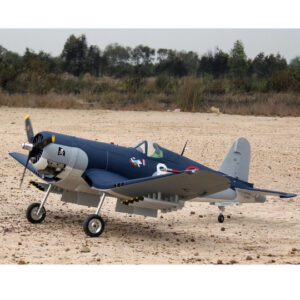The F4U Corsair, an American fighter aircraft renowned for its distinctive inverted gull wings and powerful performance during World War II, has left an indelible mark on popular culture and media. As one of the most iconic aircraft of its era, the Corsair’s legacy extends far beyond its military achievements, permeating various facets of entertainment and artistic expression. This aircraft’s presence in popular culture is not merely a reflection of its historical significance but also a testament to its enduring appeal and the fascination it continues to inspire.

Transitioning to the realm of cinema, the F4U Corsair has frequently been depicted in war films and documentaries, illustrating its pivotal role in the Pacific Theater. Notably, the aircraft was prominently featured in the 1976 television series “Baa Baa Black Sheep,” which dramatized the exploits of Marine Corps fighter squadron VMF-214, led by the legendary Major Gregory “Pappy” Boyington. The series not only brought the Corsair into the homes of millions but also solidified its status as a symbol of American air power and resilience. Through vivid aerial combat scenes and compelling storytelling, the show highlighted the Corsair’s formidable capabilities and the bravery of its pilots.
In addition to its appearances on the small screen, the Corsair has also been immortalized in various video games, offering players a chance to experience the thrill of piloting this remarkable aircraft. Games such as “War Thunder,” “World of Warplanes,” and “Microsoft Flight Simulator” have meticulously recreated the Corsair, allowing aviation enthusiasts and gamers alike to engage with its rich history interactively. These digital representations often emphasize the aircraft’s speed, maneuverability, and firepower, providing an immersive experience that pays homage to its wartime contributions.
Furthermore, the F4U Corsair has been a popular subject in literature, particularly within the genre of military history and aviation memoirs. Numerous books and articles have been written that detail the Corsair’s development, operational history, and the personal accounts of those who flew it. Works such as Barrett Tillman’s “Corsair: The F4U in World War II and Korea” and Bruce Gamble’s “Black Sheep One: The Life of Gregory ‘Pappy’ Boyington” provide readers with in-depth analyses and narratives that bring the aircraft’s storied past to life. These publications serve to educate and inspire, ensuring that the Corsair’s legacy is preserved for future generations.
Moreover, the Corsair’s impact extends into the realm of scale modeling, where enthusiasts meticulously recreate detailed replicas of the aircraft. Scale models of the F4U Corsair are highly sought after, with modelers often dedicating significant time and effort to achieve historical accuracy and precision. This hobby not only celebrates the engineering marvels of the Corsair but also fosters a deeper appreciation for its role in aviation history.
In conclusion, the F4U Corsair’s impact on popular culture and media is a multifaceted phenomenon that underscores its iconic status and lasting legacy. From its dramatic portrayals in television and film to its interactive presence in video games, literature, and scale modeling, the Corsair continues to captivate and inspire. Its storied history and distinctive design have ensured that it remains a symbol of bravery, innovation, and excellence in aviation, resonating with audiences across generations.